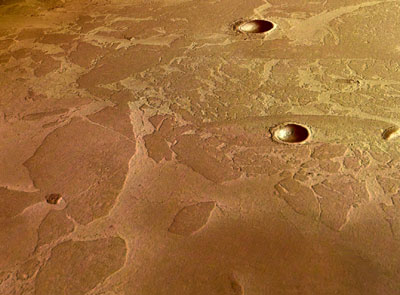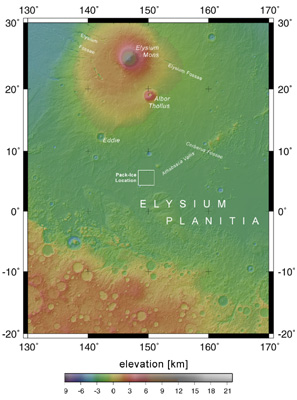Elysium Planitia

A flat plain that is part of Elysium Planitia. The image, taken by the Mars Express spacecraft, shows what some scientists think is a dust-covered frozen sea. The scene is a few tens of kilometers across, centered on latitude 5°N and longitude 150°E.

Map showing the location of the image at top.
Elysium Planitia is the second largest volcanic region on Mars after Tharsis Montes. It lies on a broad dome measuring about 1,700 by 2,400 kilometers (1,060 by 1,490 miles) in size. Located on Elysium Planitia are the volcanoes Elysium Mons, Hecates Tholus, and Albor Tholus.
Elysium Mons, the largest volcano in this region, has base dimensions of 420 by 500 by 700 kilometers (260 by 310 by 435 miles) and rises 13 kilometers (8 miles) above the surrounding plains. Its summit caldera is about 14.1 kilometers (8.8 miles) in diameter.
Hectas Tholus is 160 by 175 kilometers (100 by 109 miles) in size with a caldera complex spanning 11.3 by 9.1 kilometers (7 by 5.7 miles). Albor Tholus measures 160 by 150 kilometers (100 by 93 miles) with a summit caldera of 35 by 30 kilometers (22 by 19 miles). Its northwest flanks have been partially buried by lava flows from Elysium Mons.
A frozen sea?
In 2005, an international team of geologists studying images returned by Mars Express theorized that a frozen sea once existed on Elysium Planitia. They drew their conclusions from patterns seen in the ground near Athabasca Vallis, a region at 5°N and 150°E, about 1,180 kilometers (730 miles) south of Elysium Mons.
The idea is that that there was an eruption of water from deep underground and a subsequent catastrophic flood that covered a wide area. Where the water ended up formed an enclosed basin, about 800 by 900 kilometers (500 by 560 miles) and roughly 45 meters (150 feet) deep – similar in size and depth to the North Sea on Earth.
Water flowing into the basin would have ponded and frozen over quickly. Plate-like surface features that resemble pack ice on Earth, clearly visible in the Mars Express photos, may still harbor buried blocks of ice, protected by a layer of volcanic ash, the researchers suggested.
Another recent finding by Mars Express has increased the interest in this region. The probe's Planetary Fourier Spectrometer has detected elevated concentrations of methane in the atmosphere over the Elysium Planitia. Other scientists, however, dispute the amount of the methane concentrations. On Earth, nearly all methane has a biological origin, but the gas can be produced by volcanic processes.


